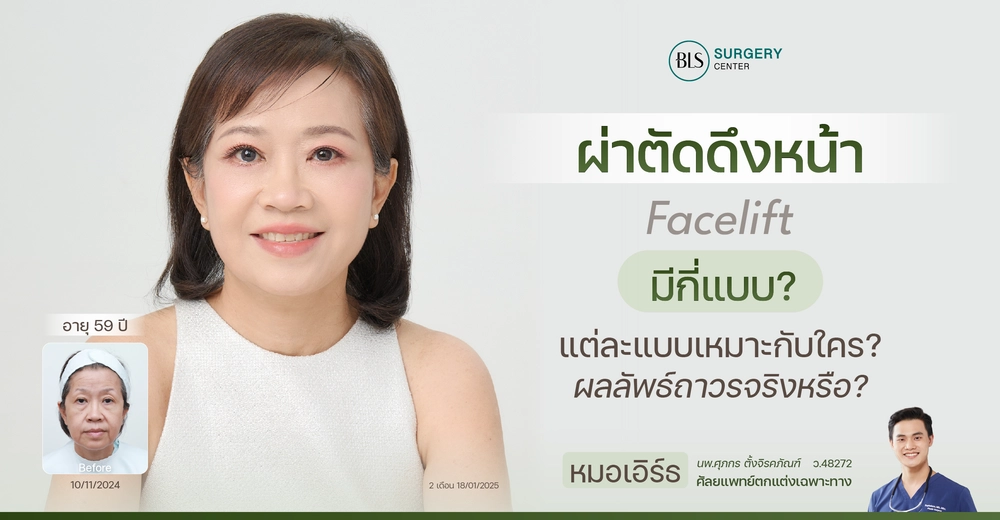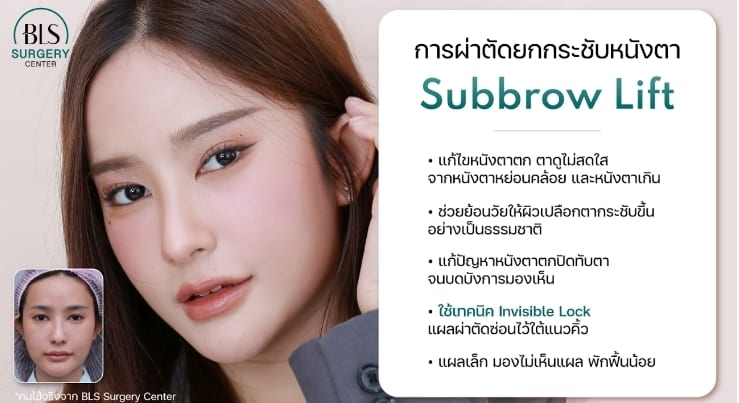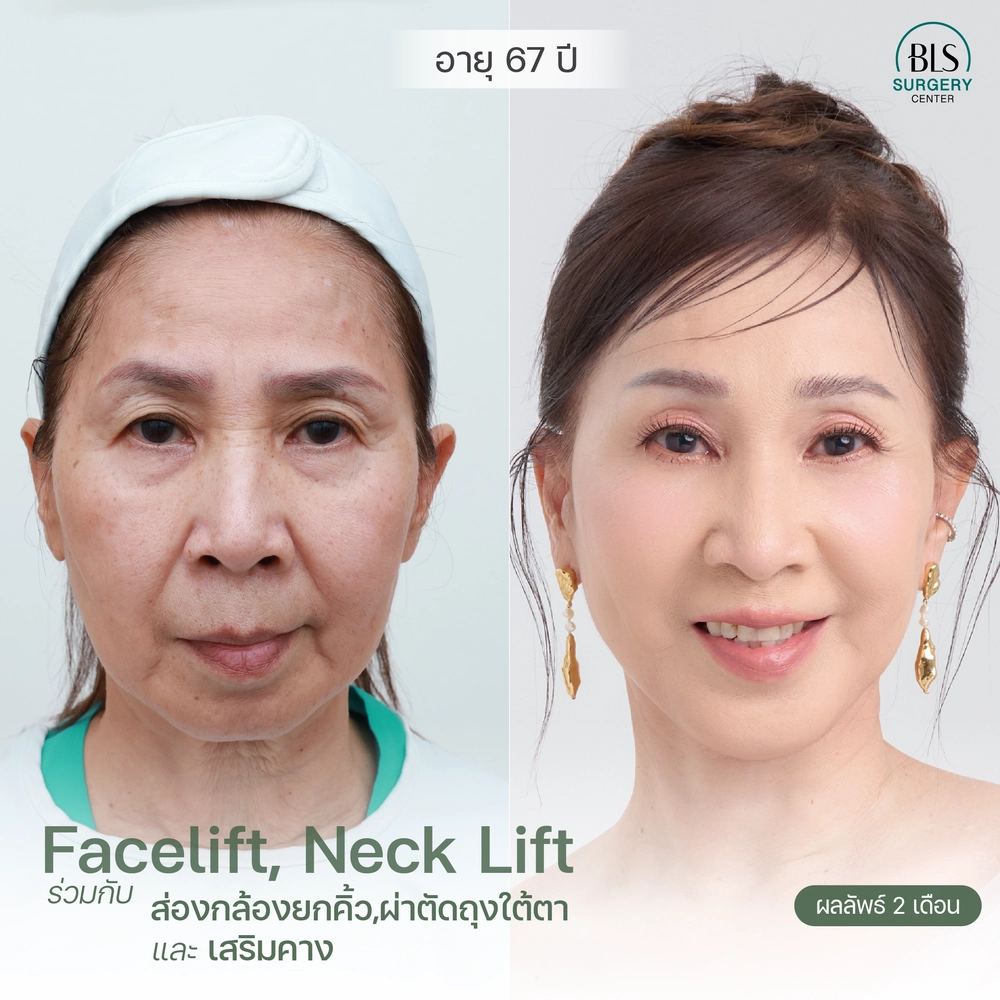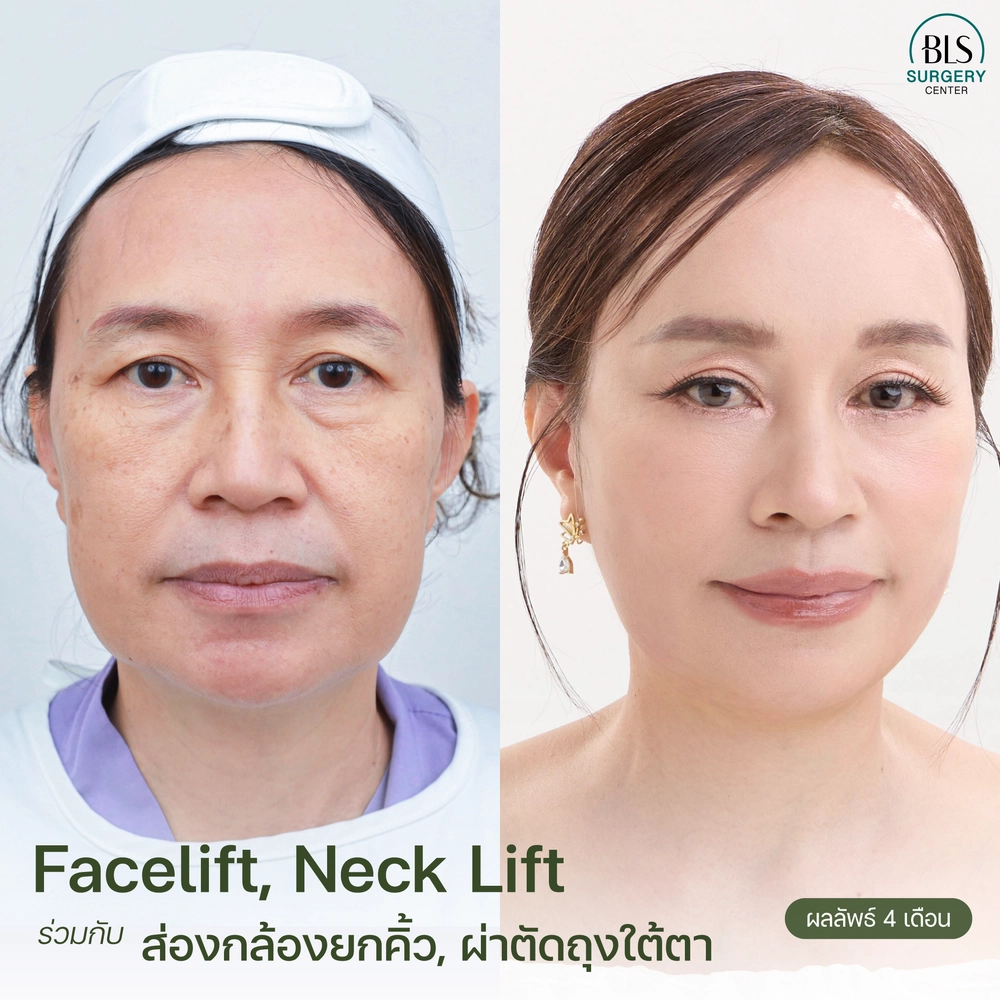
As time passes and age increases, skin that was once firm and smooth begins to sag and show signs of aging. This issue can be addressed through various methods—from temporary solutions lasting a few months such as thread lifts, botulinum toxin injections, or HIFU, to long-term solutions lasting up to a decade like “facelift surgery.”
BLS Surgery Center introduces “facelift surgery,” a valuable procedure often overlooked due to misconceptions that it’s frightening or risky. But is facelift surgery truly dangerous? Does it really deliver long-lasting firmness? This article has the answers.
What Causes Skin Sagging?
Skin sagging results from the deterioration of various layers within the skin, making it unable to maintain its original firmness. The degeneration of cells and skin layers can be explained as follows:
- Collagen and elastin cells decrease: These two cell types are essential for maintaining smoothness and elasticity. As we age, the body produces fewer of these cells, and existing ones deteriorate faster, leading to sagging skin.
- Slower skin cell turnover: Aging skin becomes rough and remains on the surface longer, making wrinkles and sagging more visible.
- Reduced fat layer: Known as “baby fat,” this layer keeps skin youthful. As it thins with age, the skin loses volume and firmness.
- Weakened SMAS tissue: The SMAS (Superficial Musculo Aponeurotic System) layer lies between fat and muscle. When it weakens, the skin begins to sag and droop.

Skin sagging can begin as early as age 25 and becomes more noticeable with age.
Factors Contributing to Skin Degeneration and Reduced Cell Renewal Include:
- Aging: The primary factor—cell turnover slows and deteriorates over time.
- Sun exposure and lack of sunscreen: UV rays generate free radicals that damage skin and accelerate sagging.

- Alcohol and smoking: These introduce toxins and destroy skin cells that maintain youthfulness.
- Polluted environments: Exhaust fumes, dirt, and airborne chemicals create free radicals and disrupt cellular function.
- Sleep deprivation: Reduces growth hormone production, accelerating skin aging.
- Poor nutrition: Lack of antioxidants and vitamins weakens skin’s ability to fight degeneration.
- Low water intake: Water supports collagen production. Insufficient hydration reduces skin firmness.

Common Areas Affected by Skin Sagging:
- Forehead: The uppermost part of the face shows clear wrinkles and lines when sagging occurs.
- Outer eye corners: Sagging here causes droopy eyes, a sad appearance, and visible aging.
- Glabella (between the brows): Frequent facial expressions like frowning create permanent lines, making the face look tense or stern.
- Nasolabial folds: Sagging cheeks form deep lines from the nose to the mouth corners.
- Jawline and submental area: Gravity pulls skin downward, creating double chin and undefined jawline.
- Neck: Wrinkles and folds in the neck are prominent signs of aging, making the neck appear loose and less youthful.
How Facelift Surgery (Facelift) Corrects Skin Sagging
Facelift surgery involves removing or tightening sagging facial skin. Some clinics use medical-grade implants or anchors to lift and secure the skin.
What Is Facelift Surgery?
Facelift surgery, or facial tightening surgery, corrects sagging by lifting or trimming the SMAS layer in affected areas. Excess skin is removed, providing long-term results that last for years.
Many believe facelift surgery only involves incisions above the ears to lift sagging cheeks. In reality, there are multiple types tailored to individual concerns:
1. Full Facelift Surgery
This comprehensive procedure addresses sagging across the entire face—from upper to lower regions.
- Upper face lift: Elevates brows and forehead, ideal for drooping brows, outer corners, and forehead wrinkles. Post-op, brows appear naturally lifted and eyes look refreshed.
- Midface lift: Targets sagging cheeks, tear troughs, and nasolabial folds by lifting the cheekbones. Deep lines become noticeably shallower.
- Lower face lift: Corrects marionette lines, lower cheeks, and neck sagging. It enhances jawline definition and tightens under-chin fat (“double chin”).
Full facelift is ideal for individuals with significant facial and neck sagging, especially those aged 40 and above. For milder concerns or younger patients, targeted procedures may be more appropriate.
At BLS Surgery Center, Full Facelift uses the Invisible Lock technique. Incisions are hidden along the hairline or behind the ears, making scars invisible or barely noticeable—even immediately post-op. Scars fade within a month and eventually disappear.

2. Mini Facelift Surgery
Mini Facelift targets specific areas, mainly the upper face—temples, outer eyes, brows, and upper cheeks. Though results are comparable to Full Facelift, this method is more preventive.
Mini Facelift suits younger individuals concerned about early signs of sagging. Incisions are small, and recovery is quick.
At BLS Surgery Center, Mini Facelift uses the Invisible Lock technique to hide incisions within or along the hairline, ensuring a natural, scar-free appearance.

3. Neck Lift Surgery
Neck Lift focuses on tightening the upper neck and under-chin area. It removes excess skin, smooths wrinkles, reduces submental fat, and tightens neck muscles—restoring a firm, youthful neck and enhancing jawline definition.
At BLS Surgery Center, Neck Lift uses the Invisible Lock technique with incisions hidden behind the ears.

4. Subbrow Lift Surgery
Subbrow Lift corrects drooping eyelids, excess skin, and sagging that obstructs vision or ages the face. It removes excess skin and tightens the upper eyelid area, restoring brightness and vitality.
At BLS Surgery Center, Subbrow Lift uses the Invisible Lock technique with tiny incisions hidden beneath the brow, ensuring fast recovery and invisible scars.

5. Lower Blepharoplasty (Under-Eye Bag Surgery)
This procedure removes bulging fat and sagging skin under the eyes, which causes puffiness, dark circles, and a tired appearance. It rejuvenates the face and brightens the eyes.
At BLS Surgery Center, under-eye surgery uses hidden incisions inside the eyelid for younger patients, and beneath the lower lash line for older individuals or those with severe under-eye concerns.

Benefits of Facelift Surgery
- Tightens sagging skin
- Reduces facial wrinkles
- Restores youthful appearance
- Provides long-term results lasting 5–10 years
Who Is Suitable for Facelift Surgery?
- Individuals with drooping eyelids and outer corners
- Those with under-eye bags
- People with nasolabial folds
- Individuals with prominent marionette lines
- Those with sagging cheeks
- People with double chin or wrinkled neck
- Individuals with undefined jawline
- Anyone seeking long-term correction of sagging and wrinkles

Is Facelift Surgery Truly Permanent?
Although facelift surgery delivers long-lasting results for many years, it is not permanent. The duration of results varies depending on the surgical technique and post-operative care of each patient.
How Long Does Facelift Surgery Take?
The procedure typically takes around 4–5 hours, with a recovery period of approximately one week.
Pre-Surgery Preparation for Facelift
- Consult with the doctor about the surgical approach and the areas of skin laxity you wish to address.
- Inform the doctor of your medical history, chronic conditions, medications, supplements, and any known drug allergies in advance.
- Discontinue medications that affect blood circulation, blood thinners, vitamins, and herbal supplements as instructed—at least 2 weeks prior to surgery.
- Avoid smoking and alcohol consumption for at least 2–4 weeks before surgery.
- Since general anesthesia is used, refrain from eating or drinking for at least 6–8 hours before surgery.
- Ensure adequate rest before the procedure.
Post-Surgery Care After Facelift
- Clean the incision area daily, 1–2 times per day, using saline-soaked cotton pads to gently wipe the wound.
- Avoid touching the wound or applying pressure that could risk tearing.
- Take prescribed medications as directed by the doctor.
- For the first 24 hours, keep the wound dry to reduce infection risk. After that, you may wash your face as usual.
- Apply cold compresses during the first 1–2 days to reduce swelling.
- After 2 days, switch to warm compresses.
- Sleep with your head elevated for the first 2–3 days to minimize swelling.
- After 3 days, you may wash your hair using a gentle shampoo. Avoid using a hairdryer or hot air.
- For the first 2 weeks, avoid spicy foods, fermented items, and seafood to prevent wound inflammation.
- Refrain from smoking and alcohol consumption.
How to Maintain Youthful Skin After Facelift Surgery
After facelift surgery, patients regain skin firmness. However, healthy and resilient skin contributes to longer-lasting results.
In addition to the surgery, patients should maintain proper skin care to extend the firmness and youthfulness of their skin, such as:
- Avoid sun exposure. If outdoors, always apply sunscreen with SPF 50+ or higher.
- Regularly moisturize the skin.
- Get sufficient sleep and avoid sleep deprivation.
- Drink adequate water daily.
- Eat a balanced diet with all five food groups, including vitamins and minerals that nourish the skin.
- Avoid alcohol and smoking.
Why Choose Facelift Surgery at BLS Surgery Center?
BLS Surgery Center offers facelift surgery using the “Invisible Lock” technique, which hides surgical scars from view. Incisions are concealed along the hairline or behind the ears, making them difficult to detect. The wounds are small, swelling is minimal, and recovery is fast—allowing patients to resume daily life quickly.
Facelift procedures at BLS Surgery Center are performed by board-certified plastic surgeons. An anesthesiologist administers general anesthesia, and the operating room meets hospital-grade standards. Patients can be assured of safety, cleanliness, and expert care.
Before surgery, BLS Surgery Center’s doctors plan each case individually, considering the patient’s expectations and skin concerns. This leads to a tailored surgical strategy that effectively addresses the issues.
Additionally, BLS Surgery Center’s doctors prioritize natural-looking results that harmonize with the patient’s facial structure. The outcome is a naturally rejuvenated appearance with restored firmness and smoothness.How Much Does Facelift Surgery Cost?
For information about facelift services at BLS Surgery Center, or to register for a free consultation with a board-certified plastic surgeon, click the button below.
Review of facelift surgery at BLS Surgery Center










